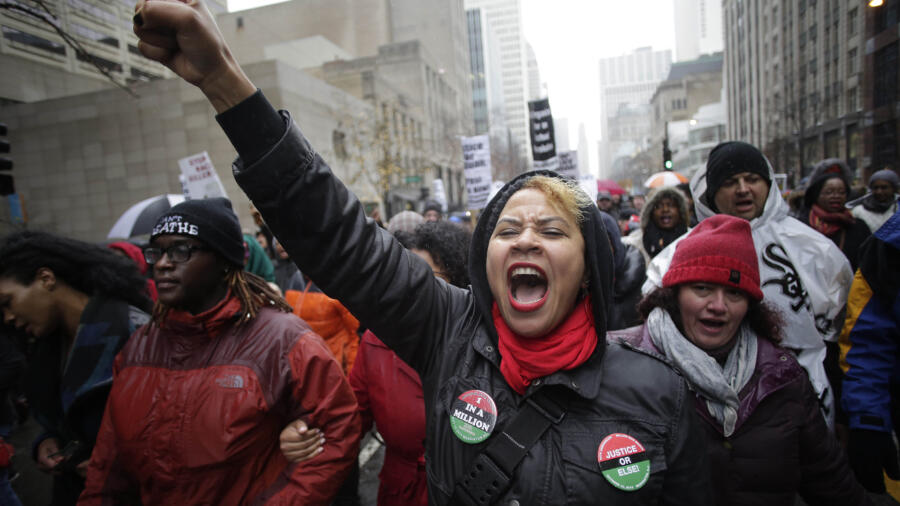A Teenager with a Future—Erased in Seconds
Laquan McDonald wasn’t a name the world knew—until October 20, 2014.
That night, on a cracked stretch of road on Chicago’s southwest side, the 17-year-old was shot 16 times by Officer Jason Van Dyke, turning a routine call into a national reckoning.
What followed wasn’t just another tragic death. It was a coordinated cover-up, an uprising, and a courtroom drama that exposed the fault lines of racism, brutality, and silence in American policing.
This wasn’t just a murder. It was a movement.
Who Was Laquan McDonald?
Laquan wasn’t perfect—but he was trying.
- A foster child.
- A teenager battling trauma, poverty, and learning disabilities.
- A young man working hard at Sullivan House High School, pulling in A’s and B’s while finding hope in art and structure.
He had dreams. He had people who believed in him. What he didn’t have… was time.
The Fatal Encounter: October 20, 2014
Police were called after reports of someone breaking into trucks. Laquan, carrying a three-inch pocket knife, was spotted walking away from the scene—not charging, not lunging.
Then Officer Van Dyke arrived.
In under 6 seconds, Laquan was hit with the first bullet. He spun, fell. And then, as he lay motionless on the ground, Van Dyke kept shooting.
Not once. Not twice. 16 times.
Bullets tore through his legs, arms, back, chest—even as his body twitched only from the force of each impact.
The Official Lie—and the Silence That Followed
At first, police claimed Laquan had lunged with a knife. Case closed.
No dashcam footage released.
No accountability.
A $5 million city settlement—quietly approved before a single lawsuit was even filed.
Justice had a muzzle.
But a group of journalists, activists, and legal advocates refused to let the story die. Over 400 days passed. Then, under court order, the truth exploded onto screens.
The Video That Changed Everything
The footage was undeniable:
- Laquan was walking away.
- Van Dyke opened fire without warning.
- The teenager dropped—but was still shot 15 more times as he bled out.
That night, Chicago erupted.
Downtown filled with voices chanting: “16 shots! 16 shots!”
The truth had gone viral—and so had the outrage.
The Fallout: When Power Starts to Crack
The consequences were swift—and staggering:
- Police Superintendent Garry McCarthy was fired.
- State’s Attorney Anita Alvarez was voted out.
- Mayor Rahm Emanuel bowed to pressure and didn’t run for reelection.
- The Department of Justice launched a full investigation.
What they found was chilling:
A culture of abuse, systemic racism, and a department that had long protected its own at the cost of truth.
The Trial: Justice… or Just a Glimpse of It?
In 2017, Van Dyke became the first Chicago officer in over 50 years to be charged with first-degree murder for an on-duty killing.
In court, his lawyers painted Laquan as dangerous. But the video, the forensic evidence, and public opinion said otherwise.
In 2018, Van Dyke was convicted of:
- Second-degree murder
- 16 counts of aggravated battery
The sentence? 6 years and 9 months.
He served less than 4—and was released in 2022.
To many, it was a slap in the face.
What Changed Because of Laquan McDonald?
A lot—and not enough.
✅ A consent decree forced police reform in Chicago.
✅ Officers now face tighter scrutiny on use-of-force.
✅ Dashcam and bodycam footage is required to be released sooner.
✅ Civilian oversight boards have expanded.
But still, the violence continues. Still, Black communities live under the weight of systemic distrust.
Laquan’s case may have cracked the walls—but the foundation is still flawed.
The Power of a Name
Laquan McDonald became more than a headline.
He became a symbol. A call. A fire.
His name was spray-painted on concrete.
Shouted in marches.
Etched into the city’s conscience.
And still today, it echoes.
Because justice isn’t a verdict—it’s a revolution.
FAQs About Laquan McDonald’s Death
Why was Laquan McDonald shot?
He was walking away from police holding a small knife. Officer Jason Van Dyke claimed Laquan was threatening him, but video proved otherwise.
How many times was he shot?
16 times, even after falling to the ground.
Was the officer held accountable?
Van Dyke was convicted of second-degree murder and 16 counts of aggravated battery but served less than 4 years in prison.
What reforms came from the case?
The DOJ forced a consent decree on CPD, requiring major changes in training, use-of-force policies, and accountability.
What was the public’s reaction?
Mass protests erupted across Chicago. Public officials lost their jobs. Activists launched ongoing campaigns for police reform.

